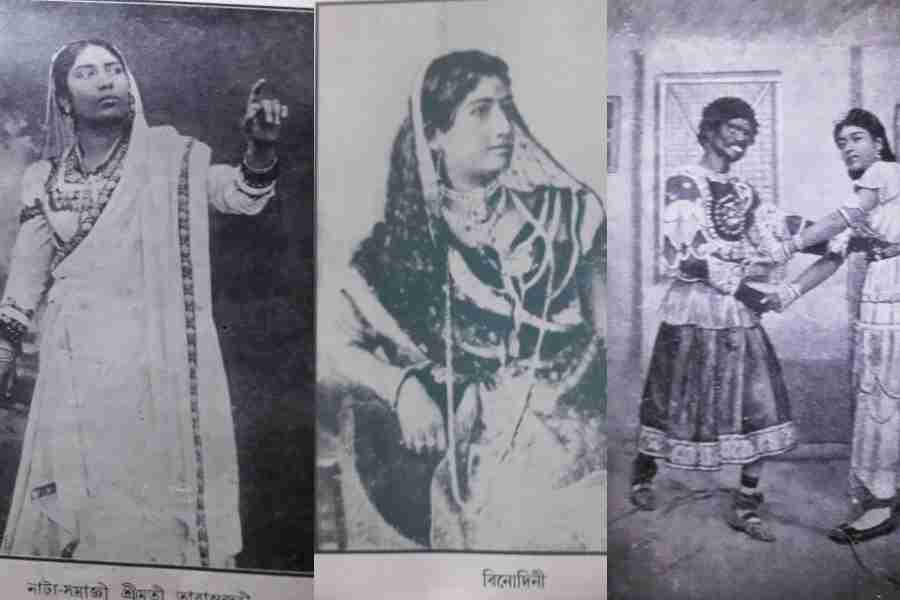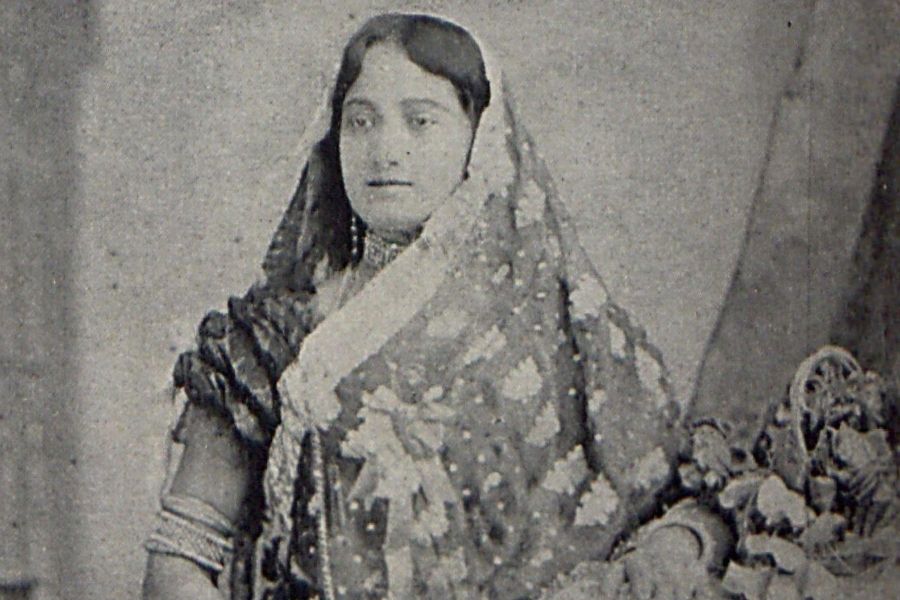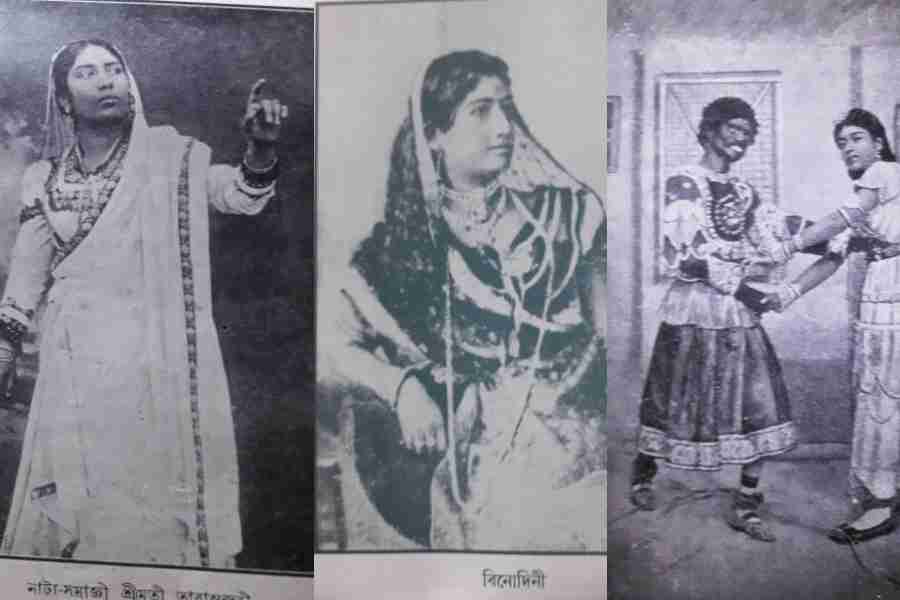In the early days of modern Bengali theatre, before the second half of the 19th century, it was men who played all the roles, including the female ones. Women were absent — not just from the stage, but from the very idea of public performance.
The theatre, then, was a curious space — a kind of manufactured reality.
Here, colonial fantasies played out through native actors who had no real ties to the colonial power. Ironically, the very people who were economically and socially on the margins were being made to perform imperial acts.
The Bengal Renaissance was a time of multifaceted modernisation. This affected literature, art, education, and theatre too. One important change during this time was the gradual move away from men cross-dressing in plays, to allowing women to perform on stage.
‘Public women’
It was only in the late 1800s that native women began entering the stage.
Most of these women came from economically vulnerable backgrounds, especially from Kolkata's red-light districts.
These were women already marked as ‘public women’ — visible, available, and often sexualised, and that’s precisely why they were allowed into public entertainment spaces. Their visibility, their bodies, their personas, all became a part of the spectacle.
The actress was turned into a kind of consumer product for the male gaze.
In patriarchal societies, the public sphere, especially public entertainment, has always been male-dominated. Bengali theatre followed this pattern, too. And when women finally entered the stage, they were still under intense scrutiny and judgment.
The entry of women onto the Bengali stage coincided with the arrival of realism in theatre. This was a time when theatre became a space for imagining a new nation — and women became a symbol in that vision. She was at once the motherland, the moral centre, and the romanticised figure of change.
Ironically, these women, many of whom were socially outcast, became key players in the performance of nationalist imagination.
A versatile and admired performer
Binodini Dasi, born in 1863, is one of the most iconic figures of this period. She was a sex worker, who later became a celebrated stage actress in Kolkata. Her career lasted just over a decade, but in that short time, she became a towering figure in Bengali theatre. Her mentor was Girish Chandra Ghosh — a legendary name in Indian theatre. Under his guidance, Binodini grew into a versatile and admired performer. But despite her fame and success, she left the stage in her prime to live a more homely life.
In the early 1950s, French philosopher Simone de Beauvoir wrote The Second Sex, a foundational text of existential feminism. In it, she introduced the idea of ‘Otherness’.
De Beauvoir argued that men are considered the default — the Absolute — and women are defined only in relation to them.
When we apply this concept to Binodini’s life, it gives us a powerful lens through which to understand her struggles. Despite her passion, talent, and enormous contributions to theatre, her identity as a woman, and as a former sex worker, constantly marked her as the ‘Other’.
Binodini’s life story reflects this deeply entrenched patriarchy. She was married off at around the age of five, but that marriage didn’t last. Her mother, who herself was struggling, arranged for music lessons for her when she turned seven. These were given by a singer named Gangabai. Gangabai helped her get into theatre. Two important theatre personalities, Purna Chandra Mukherjee and Brajanath Seth, were introduced to her through Gangabai. They got her admitted to Bhuban Mohan Niyogi’s Great National Theatre, marking the beginning of her career.

(L-R) Tarasundari, Nati Binodini and Kusumkumari TT Archives
She belonged to the second generation of Bengali actresses, following names like Elokeshi, Ganga Baiji, Golapshundari, Khetramoni, Lakkhimoni, and Rajkumari, all of whom Binodini names in her life works, Amar Katha, published in 1912.
Despite her background, Binodini Dasi rose to prominence through sheer talent and dedication. She took lessons from major names in Bengali theatre, Mahendra Lal Bose and Ardhendu Sekhar Mustafi. After short stints at Great National Theatre and Bengal Theatre, she joined National Theatre in 1877, where she stayed for six years.
Under Girish Chandra Ghosh, her mentor and guru, she mastered the craft of acting. But even here, her relationship with power was complicated. Girish persuaded her to become the mistress of a wealthy Marwari man named Gurmukh Rai to help build Star Theatre.
‘How can a theatre be named after a woman?’
In her book, Binodini described her excitement during the initial days of the Star. She was promised that the theatre would be named after her — B Theatre. But it was ultimately named Star Theatre. The argument being — how can a theatre be named after a woman?
Binodini wrote, “Why was I not allowed to inaugurate Star Theatre, even though it was built with money I helped bring in?”
The question is both personal and political. It reveals how closely power and respectability were tied, and how easily women could be discarded once they outlived their usefulness.
In a move to acknowledge her legacy, West Bengal Chief Minister Mamata Banerjee announced in December, 2024, that the Star Theatre would be renamed ‘Binodini Mancha’.

in December, 2024, Mamata Banerjee announced that Star Theatre would be renamed ‘Binodini Mancha’
Binodini played over 80 roles in her 12-year-long career. From Pramila in Meghnad Badh Kabya to Sita, Draupadi and Radha in mythological tales, to Mrinalini and Ayesha in adaptations of Bankim Chandra Chattopadhyay’s works. She was praised for her transitions between vastly different characters — from the pious to the tragic, the divine to the sensual.
Amar Katha remains one of the most honest accounts of a woman navigating the patriarchal world of theatre. What stands out in her writing is her awareness of gendered injustice. She doesn’t shy away from revealing how her body was used, how her worth was constantly questioned, and how she was denied the same respect and opportunities given to her male peers.
What it meant to be a female performer in 19th-century Bengal
In Amar Katha, we also see the evolution of Binodini as a thinker — someone who was not just reacting to injustice but trying to understand it. She reflects on the role of the actress, the audience’s gaze, and the many contradictions of a society that celebrated her on stage, but shamed her off it. Through her words, she gives us a first-hand account of what it meant to be a female performer in 19th-century Bengal. She moves between self-doubt and defiance, vulnerability and strength, showing us that she was never just a victim, but a sharp observer of the world around her.
Binodini Dasi’s life is still relevant because it forces us to ask difficult questions. How do we remember women who refuse to fit into neat boxes? How do we honour labour when it comes from those already marginalised? And how much has really changed for women in performance spaces today?
Today, her face appears on theatre posters, her name is invoked as a symbol of strength, and yet, many still don’t know her full story. There are plays, films, and books inspired by her, but few capture the complexity of her life, her ambitions, her betrayals, her clarity, and her contradictions.
To remember Binodini Dasi is to remember a woman who dared to want more, not just for herself but for the art she helped shape. In an age when women are still fighting for agency, respect and recognition, Binodini Dasi’s words echo across generations. Her story isn’t just a part of theatre history; it’s a part of the ongoing narrative of women reclaiming their voices, their power and their rightful place in history. She reminds us that history is not just made by kings and saints, but also by actresses, sex workers, and other women who wrote their stories from the margins.


